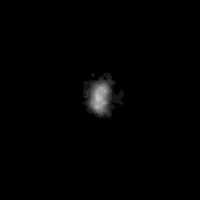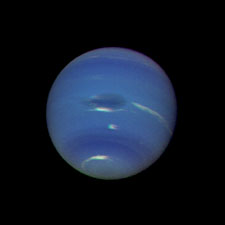
Gerard Kuiper discovered the third-largest moon of Neptune in 1949. This Voyager view of Nereid taken on August 24, 1989, shows the moon at a resolution of 43 kilometers (26.6 miles) per pixel. Recent research suggests that, like Triton, the moon was captured after the Neptunian system formed.
Courtesy NASA/JPL.
Neptune, it seems, likes harboring stowaways. Astronomers already knew that its largest satellite, Triton, didn't form along with the planet's other moons. It now appears that another body, Nereid, also jumped onboard.
Nereid has perplexed scientists since its discovery in 1949. The moon's highly eccentric (non circular) orbit is inclined some 28° with respect to Neptune's equatorial plane. Last week, at the American Astronomical Society's Division of Planetary Sciences meeting in Monterey, California, Anthony R. Dobrovolskis (NASA/Ames Research Center) showed evidence explaining how Neptune's third largest moon got to be that way.
"People have spent years trying to explain away Nereid's inclination," says Dobrovolskis. The problem was that astronomers were fixated on relating the object's inclination and eccentricity to Neptune's equatorial plane. Instead, he argues, Nereid should instead be compared to Neptune's orbital plane, in which case, the moon's inclination is only 10°.
"Instead of Nereid having a high eccentricity and a high inclination, it really has a high eccentricity and a low inclination," says Dobrovolskis. His calculations show that the moon had only a few percent chance of reaching its present location by random scattering from Neptune's inner satellite system. Thus Nereid was most likely captured from afar.

Voyager 2 imaged Neptune's blue-green atmosphere to unprecedented detail when it flew by the gas giant. Notice the great dark spot at the middle of the planet, a storm as wide as Earth.
Courtesy NASA/JPL.
Moreover, recent observations of Nereid by Tommy Grav (Harvard-Smithsonian Center for Astrophysics) and colleagues show that the moon rotates very fast — its day is less than 12 hours long and could be as short as 5.7 hours. According to Dobrovolskis, this is additional evidence showing that Nereid couldn't have wandered from Neptune's equatorial plane to its current orbit. Had it been near the gas giant, Nereid couldn't be spinning as fast as we see it spin today.
"Nereid never spent time close to Neptune. It didn't migrate out," says Dobrovolskis.
 0
0
Comments
You must be logged in to post a comment.